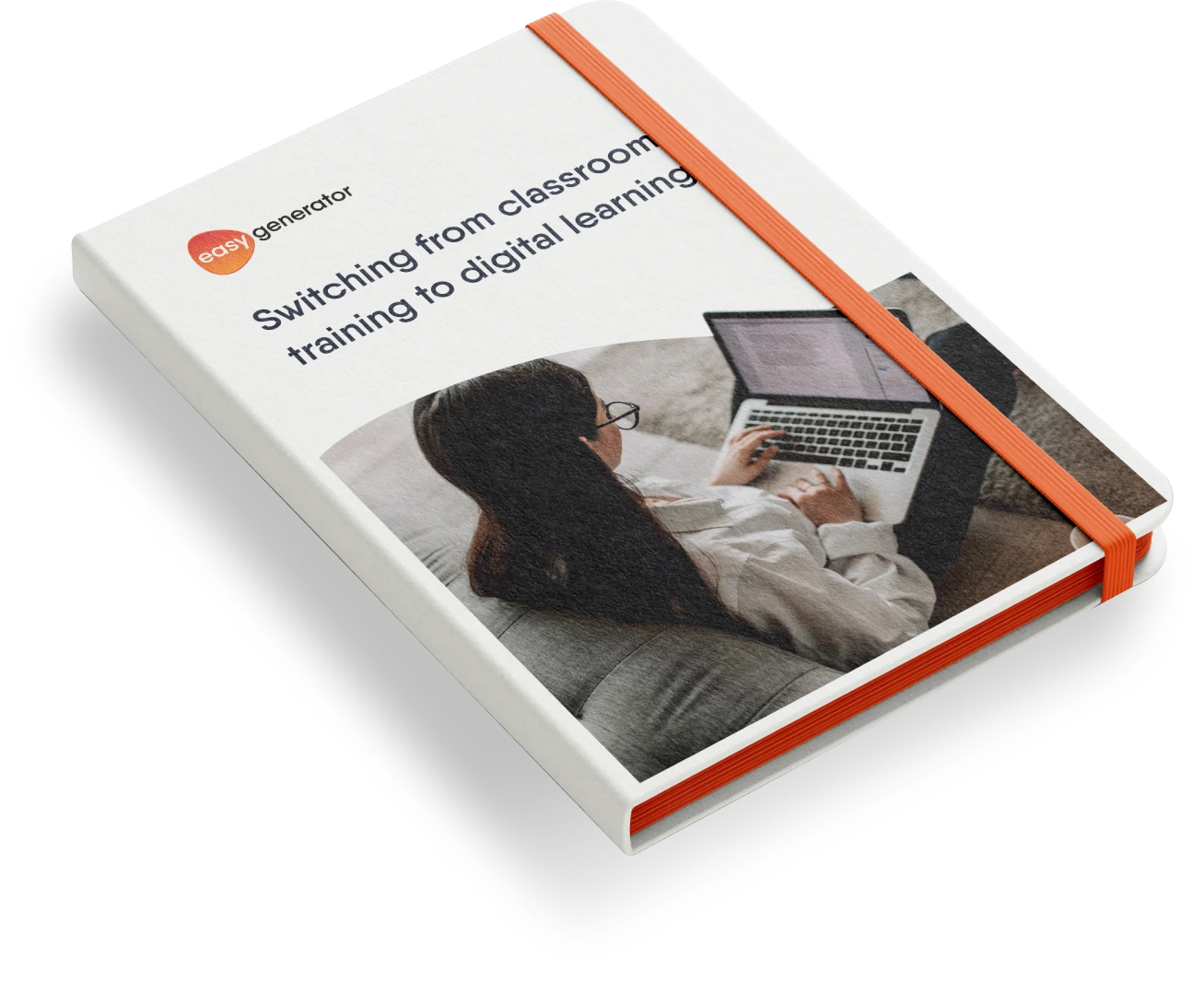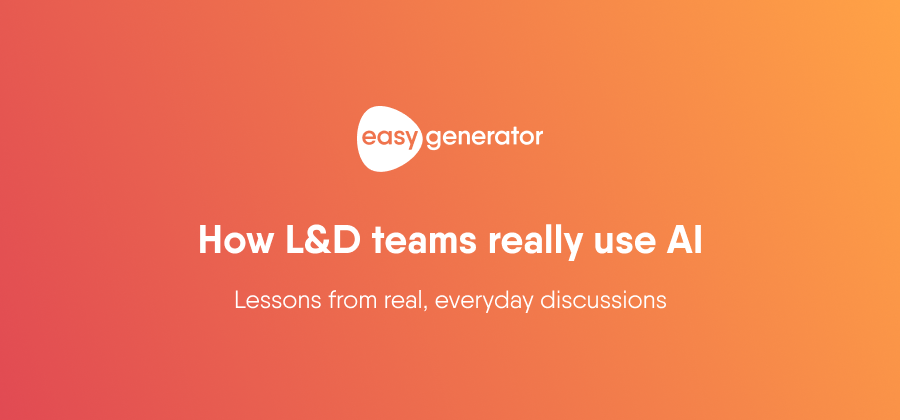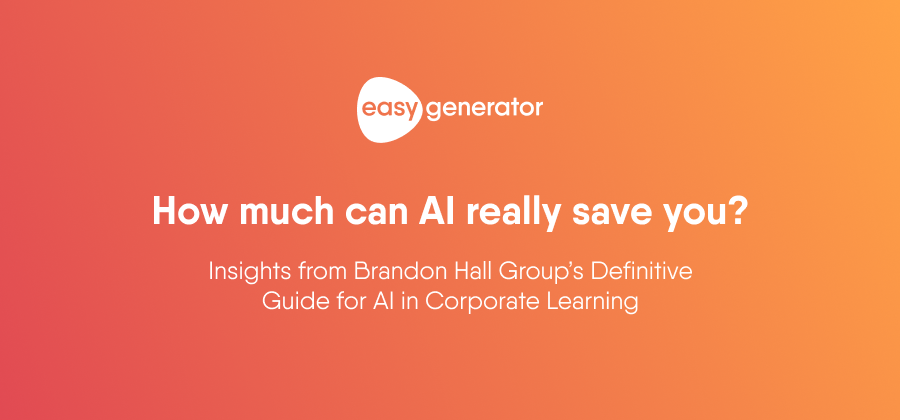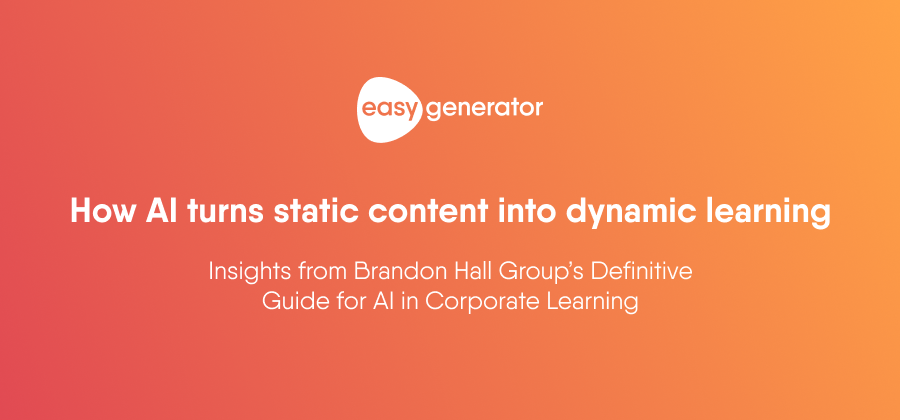Creating training materials in-house: why it’s better and how to do it
Creating training materials in-house ensures relevance, saves costs, and boosts engagement. With the right approach, you can create effective training tailored to your organization.

Creating learning materials in-house helps you deliver training that truly resonates with your employees. It allows you to tailor content to your organization’s unique needs, make training more engaging, and save costs in the long run.
But how do you get started?
In this blog, we’ll show you why in-house training is a game-changer, guide you through the steps to make it happen, and talk about the tools you’ll need.
The benefits of creating training in-house
Organizations thrive when employees have the knowledge and skills to meet evolving challenges. One way to ensure effective learning is by creating training materials in-house.
This approach offers more than just cost savings. It empowers organizations to deliver tailored and impactful training experiences.
Here’s why you should create learning content in-house:
1. Your training is tailored to your organization
By creating training materials in-house, you gain full control over the content. This means:
- Aligning training with your organization’s unique goals, processes, and culture.
- Ensuring examples, case studies, and scenarios reflect real-world challenges your team faces.
- Avoiding generic off-the-shelf programs that may not resonate with employees.
This tailored approach makes learning more engaging and directly applicable to your team.
2. You retain organizational knowledge
Your employees and managers are often your best source of organizational knowledge. In-house content creation enables you to:
- tap into their insights and experience
- have SMEs create content that’s practical and relatable
- share training materials that speak directly to your workforce
3. Save money while maintaining quality
Outsourcing training content can be expensive, especially when customization is required. With in-house content creation:
- You avoid the high costs of external vendors.
- Affordable, user-friendly tools help create professional-quality content.
- Long-term, your training budgets stretch further without sacrificing quality.
4. Adapt to the changes in your industry
In a fast-paced business environment, agility matters. Creating training materials in-house allows you to:
- Respond immediately to new technologies, processes, or regulations.
- Develop and deploy content without waiting for external vendors.
Employee-Generated Learning (EGL) takes this even further by enabling employees to:
- Create and update training content in real time.
- Ensure materials always reflect the latest tools, methods, or organizational changes.
Unlike outsourced content, where updates can mean delays and extra costs, in-house content creation keeps your training agile and responsive.
5. Build a culture of learning and collaboration
Here’s why employees create training content is important:
- It means that everyone has a role in your business’s growth.
- Learning becomes a shared responsibility, not just an L&D initiative.
- Organizational knowledge is captured, and every employee can access it.
This approach boosts morale and engagement, fostering a workplace culture that prioritizes growth.
6. Scale training to meet your organization’s growth
As your organization grows, so do your training needs. In-house content creation ensures you can:
- Onboard new hires efficiently with customized training materials.
- Upskill existing employees to adapt to new roles or responsibilities.
- Expand your training library to support workforce development at all levels.
7. Continuously improve with integrated data and feedback
When you create training materials in-house, you can easily:
- Incorporate employee performance data and feedback to refine content.
- Use insights from past sessions to improve future training.
- Ensure your training materials are always evolving for better outcomes and ROI.
By creating training materials in-house, you empower your organization to respond faster, reduce costs, and deliver training that directly supports its goals. This approach helps build a capable workforce ready to tackle challenges and thrive in the future.
How Employee-generated Learning makes in-house training better
EGL is changing how organizations create training content. By using employees’ knowledge and experience, EGL produces training materials that are relevant, practical, and easy to apply. Let’s look at what EGL is, how it supports in-house training, and who benefits from it.
What is Employee-generated Learning?
EGL is a way of creating training where employees, not just L&D teams, take the lead in making learning materials. Instead of relying on external providers or professional instructional designers, EGL lets employees—especially SMEs—create and share their knowledge.
This approach makes the most of the expertise your employees already have. Instead of being just learners, employees become contributors, creating content that is useful and relatable for their colleagues.
Who benefits from EGL?
EGL brings value to everyone involved:
- Employees: Share their knowledge, grow their skills, and feel valued for their contributions.
- Learners: Get training materials that fit their roles and challenges, making it easier to apply what they learn.
- L&D teams: Spend less time creating content and more time ensuring the quality and effectiveness of training.
- The organization: Builds a strong culture of learning, where knowledge flows across teams and adapts to change.
Why EGL and in-house training work well together
EGL improves in-house training by using employees’ knowledge to create materials that are timely, cost-effective, and relevant. Together, they help organizations build a learning culture that is flexible, collaborative, and focused on growth.
L&D-created vs. employee-generated learning materials
When creating training content, organizations need to balance materials developed by the L&D team and those created by SMEs through EGL. Both approaches have unique strengths, and knowing where to apply each is key to building an effective learning ecosystem.
The role of L&D in content creation
L&D teams are the architects of an organization’s learning strategy. Their expertise in instructional design ensures materials are pedagogically sound and aligned with business goals. Here’s where L&D should take the lead:
- Core competency training: Foundational programs, such as leadership development or compliance training, that require standardized, high-quality instruction.
- Frameworks and guidelines: Setting templates, tone, and best practices to maintain consistency across the organization.
- Complex learning journeys: Courses involving multiple modules, assessments, or certifications that require strategic planning and execution.
The role of SMEs in content creation
SMEs excel at creating content based on their specific expertise and experience. EGL allows them to share highly relevant and practical knowledge. Here’s where SMEs shine:
- Technical skills training: Hands-on knowledge about tools, software, or equipment.
- Process-specific guidance: Workflows, standard operating procedures, or troubleshooting guides.
- Local or team-specific training: Nuances in regional practices or department workflows.
Finding the right balance
To get the most out of both L&D and SME contributions, collaboration is key. L&D can act as mentors, supporting SMEs to ensure their content meets organizational standards.
L&D teams can:
- Equip SMEs with tools: Provide user-friendly platforms like Easygenerator to simplify content creation.
- Review content: Curate SME-created materials to ensure quality and alignment with organizational goals.
- Train SMEs on instructional basics: Offer guidance on design principles so their content is engaging and effective.
How to create in-house training materials with Employee-generated Learning
Implementing EGL as part of your in-house training strategy requires a step-by-step approach to ensure success and long-term impact. The book Employee-generated Learning: How to develop training that drives performance offers a detailed breakdown of these steps, along with real-world case studies that show how organizations have made EGL work. By embedding EGL into your in-house training, you can create a more dynamic, cost-effective, and engaging learning ecosystem.
This process can be divided into three key phases: Pilot, Roll-Out, and Operation. Each phase builds on the one before, making it easy to integrate EGL into your organization’s in-house training efforts.
1. The pilot phase
The pilot phase is your testing ground to see how EGL can work within your in-house training program. It’s a chance to experiment with small-scale implementation and gather feedback to refine your approach.
Select a small, representative group
- Choose a group of enthusiastic SMEs and supportive managers who can champion EGL.
- Ensure this group represents a mix of roles, departments, or regions to test the concept’s relevance across the organization.
Test tools and processes
- Introduce easy-to-use platforms, like Easygenerator, to help SMEs create in-house training materials efficiently.
- Check that the tools align with your organization’s technical and functional needs.
Experiment and collect feedback
- Let participants create and share training content.
- Monitor the process closely, gathering feedback on tools, templates, and workflows.
- Assess whether the content supports your broader in-house training goals.
Refine the approach
- Use feedback to improve templates, processes, and tool configurations.
- Address any challenges before scaling EGL to a wider audience.
2. The roll-out phase
After the pilot proves successful, the roll-out phase focuses on embedding EGL into your organization’s broader in-house training strategy.
Expand participation
- Involve more employees, teams, and departments in creating in-house training materials.
- Share success stories and pilot-phase lessons to build excitement and buy-in.
Provide training and resources
- Offer training to help employees understand how to use tools and create effective training materials.
- Share resources like instructional guides, FAQs, and a support system to empower SMEs.
Standardize processes
- Create clear workflows for creating, reviewing, and deploying in-house training materials.
- Define roles for employees, SMEs, and L&D teams to ensure consistency and efficiency.
Monitor and support
- Track roll-out progress and address challenges as they arise.
- Provide coaching and ongoing support to ensure employees are confident in their roles as contributors.
3. The operation phase
The operation phase integrates EGL into your day-to-day in-house training efforts, ensuring it becomes a sustainable and impactful part of your organization.
Sustain momentum
- Recognize and reward employees for creating training content.
- Celebrate milestones, such as launching new courses or achieving high engagement rates.
Optimize processes
- Regularly evaluate and refine EGL workflows to make content creation easier and more effective.
- Use feedback from employees and learners to improve your in-house training materials.
Scale and innovate
- Expand EGL into new areas of in-house training, like onboarding or cross-departmental learning.
- Experiment with new tools, such as AI or gamification, to make training content more engaging.
Measure impact
- Use analytics to track the effectiveness of EGL on learner engagement, knowledge retention, and business outcomes.
- Share results with stakeholders to show how EGL strengthens your in-house training efforts.
By breaking EGL implementation into these three phases—pilot, roll-out, and operation—you can:
- Safely test and refine ideas on a small scale.
- Gradually expand participation and build excitement.
- Ensure EGL becomes an integral, sustainable part of your in-house training strategy.
How to create engaging training materials with AI
The heart of EGL is empowering employees to share their expertise. However, SMEs often encounter challenges such as structuring ideas, crafting clear messages, or making content engaging. AI bridges these gaps, allowing SMEs to focus on their strengths—knowledge and experience.
Enter, AI.
AI is transforming how organizations create learning materials, making the process faster, simpler, and more accessible for employees. When combined with EGL, AI becomes a powerful tool that helps SMEs create high-quality, engaging content without needing extensive training in instructional design.
AI doesn’t replace the human element—it amplifies it.
By simplifying and enhancing the work of SMEs, AI makes EGL scalable, efficient, and impactful.
Here’s how AI supports in-house training through EGL:
Simplifying content creation
AI helps SMEs organize their thoughts, turning rough ideas into structured training materials. It suggests logical flows, breaks down complex topics, and ensures key concepts are effectively covered.
Enhancing clarity and tone
Translating technical jargon or complex information into accessible language can be tricky. AI refines wording, adjusts tone to match the audience, and improves readability, ensuring learners understand the material.
Adding visual and interactive elements
Engaging learners often requires more than text. AI can recommend or generate visuals, videos, and interactive elements that make training materials dynamic and memorable.
Personalization and adaptability
AI allows content to be tailored for specific roles, departments, or skill levels. It adapts tone, focus, and style, ensuring the materials meet the needs of diverse audiences.
Saving time
SMEs often juggle multiple responsibilities. AI speeds up the process by streamlining tasks like editing, formatting, and generating quizzes or assessments.
Wrap up
Creating training materials in-house gives your organization complete control over the quality, relevance, and cost of your learning programs. Unlike outsourced solutions, which can be expensive and often generic, in-house training lets you tailor content to reflect your unique goals, culture, and challenges.
By using EGL and AI-powered tools like Easygenerator, your team can quickly create professional, engaging training materials without relying on costly external providers. With in-house training, you save time, reduce costs, and build a learning culture that empowers employees to share their expertise while keeping content flexible and up to date.
-
 14 day trial with access to all features. Start with variety of course templates.
14 day trial with access to all features. Start with variety of course templates. -
 Get unlimited design inspirations. Level up your courses.
Get unlimited design inspirations. Level up your courses. -
 Upload your PowerPoint presentations. Get instant courses created.
Upload your PowerPoint presentations. Get instant courses created.




